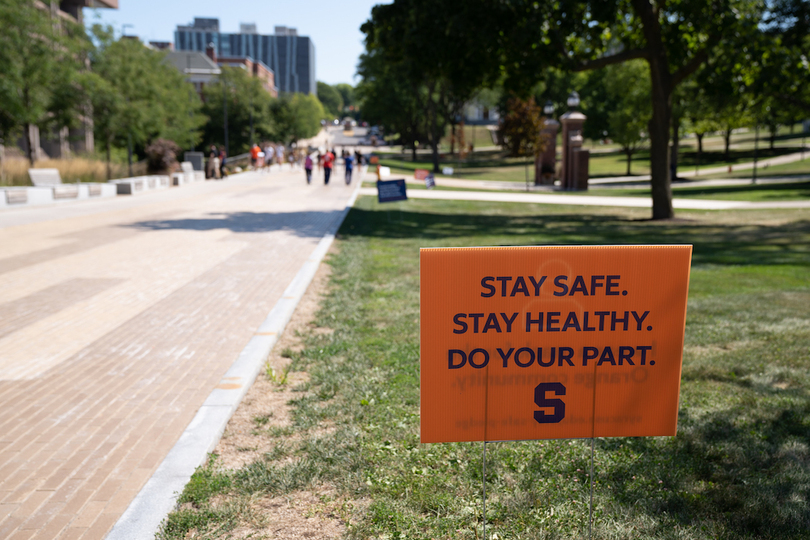Editorial Board: Both SU and its students are to blame for campus shutdown

Emily Steinberger | Photo Editor
The Daily Orange is a nonprofit newsroom that receives no funding from Syracuse University. Consider donating today to support our mission.
UPDATED: Nov. 19, 2020 at 6:33 p.m.
After 12 weeks of residential instruction, Syracuse University has transitioned classes online, a switch many of us expected to happen just two weeks after the start of the semester. Though this achievement deserves recognition, we must also recognize the flaws in SU’s COVID-19 guidelines that led to an abrupt end of in-person learning right as campus entered the home stretch.
Just as cases are rising on campus, infections are also spiking in Onondaga County. SU’s move to online learning is not solely the result of students neglecting to follow health guidelines or the university failing to enforce them. But since October, the campus community has come close to reaching the state-mandated threshold for moving classes online several times. While the SU administration may attempt to blame this sudden spike in cases on students, and vice versa, both could have done more to keep cases low.
The campus has seen multiple COVID-19 clusters among students and a lack of regulation from SU on extended and holiday weekends. As the semester draws to a close, more than 600 students, faculty and staff have contracted the virus.
Five weeks into the semester, SU’s COVID-19 testing policies worked. The number of cases were down, and this was made possible due to pre-arrival testing, mandatory randomized testing and frequent wastewater testing.
Now, some of those protocols have come to a halt. The COVID-19 saliva tests are infrequent, leaving it up to students to keep track of their health. We haven’t heard any updates about any discovered traces of COVID-19 in dorm hall wastewater. And as students begin to travel home for winter break, pre-departure testing is required but not enforced.
The university implemented an abundance of protocols at the start of the semester, but as these measures proved effective in preventing an outbreak, SU developed a sense of overconfidence that led to a lack of surveillance and enforcement.
So when Vice Chancellor Mike Haynie blamed the majority of the 280 active cases as of Tuesday on student-to-student transmission, he failed to consider that part of the blame should fall on the administration. By letting their guard down when it came to COVID-19 testing, they unintentionally sent a message to students that it’s OK to do the same.
Unsurprisingly, this recent spike in on-campus cases comes after the weekend of Halloween. Yet the university did not schedule a round of mandatory testing for immediately after a holiday where college students are known to congregate with more than five people.
Personal responsibility was obviously lost on both SU and its students during and after that weekend. Many students decided to ignore the idea of social distancing altogether when celebrating, and the university did not prepare for the aftermath of Halloween partying.
SU is lacking most in enforcement, even after implementing policies such as the Stay Safe Pledge and threatening to report students who violate it to the Office of Student Rights and Responsibilities. If the university fails to stay true to its word, students will unintentionally disregard its guidelines.
The Department of Public Safety is the main entity that has the resources to change this by enforcing mask-wearing rules and gathering limits. But while DPS needs to do more to enforce COVID-19 protocols, it’s unfair to not state the obvious: temperatures have dropped, and more people are now congregating inside and out of DPS’ immediate view.
It’s unfair to place all the blame on the students. The majority of students have stayed in central New York, have worn masks in public and have understood that other students’ health is dependent on theirs. But as the three COVID-19 clusters among students prove, not everyone in our campus community has taken public health guidelines and the safety of others seriously.
SU has done a solid job of safely bringing students back to campus, addressing COVID-19 clusters and contact tracing students who may have been exposed to the virus. But the university must diligently adhere to these practices throughout the entire semester, not just in the first five weeks.
If we resume in-person learning in the spring, SU’s campus culture needs to change. The university needs to step it up when it comes to enforcing testing, social distancing and mask-wearing protocols. Students need to start normalizing social gatherings of five people or fewer, avoiding going out to local restaurants and wearing masks properly. We’re lucky that we made it this far. But we need to be able to count on ourselves more than on luck to make it through next semester.
CORRECTION: A previous version of this post misstated SU’s COVID-19 testing schedule. The university conducted a round of testing from Oct. 20 to Oct. 27. The previous version also stated that SU has not held mandatory, randomized testing throughout the semester. The Daily Orange regrets these errors.
The Daily Orange Editorial Board serves as the voice of the organization and aims to contribute the perspectives of students to discussions that concern Syracuse University and the greater Syracuse community. The editorial board’s stances are determined by a majority of its members. You can read more about the editorial board here. Are you interested in pitching a topic for the editorial board to discuss? Email opinion@dailyorange.com.





